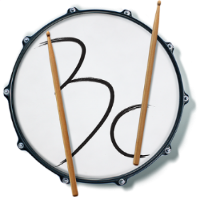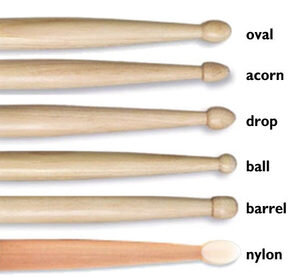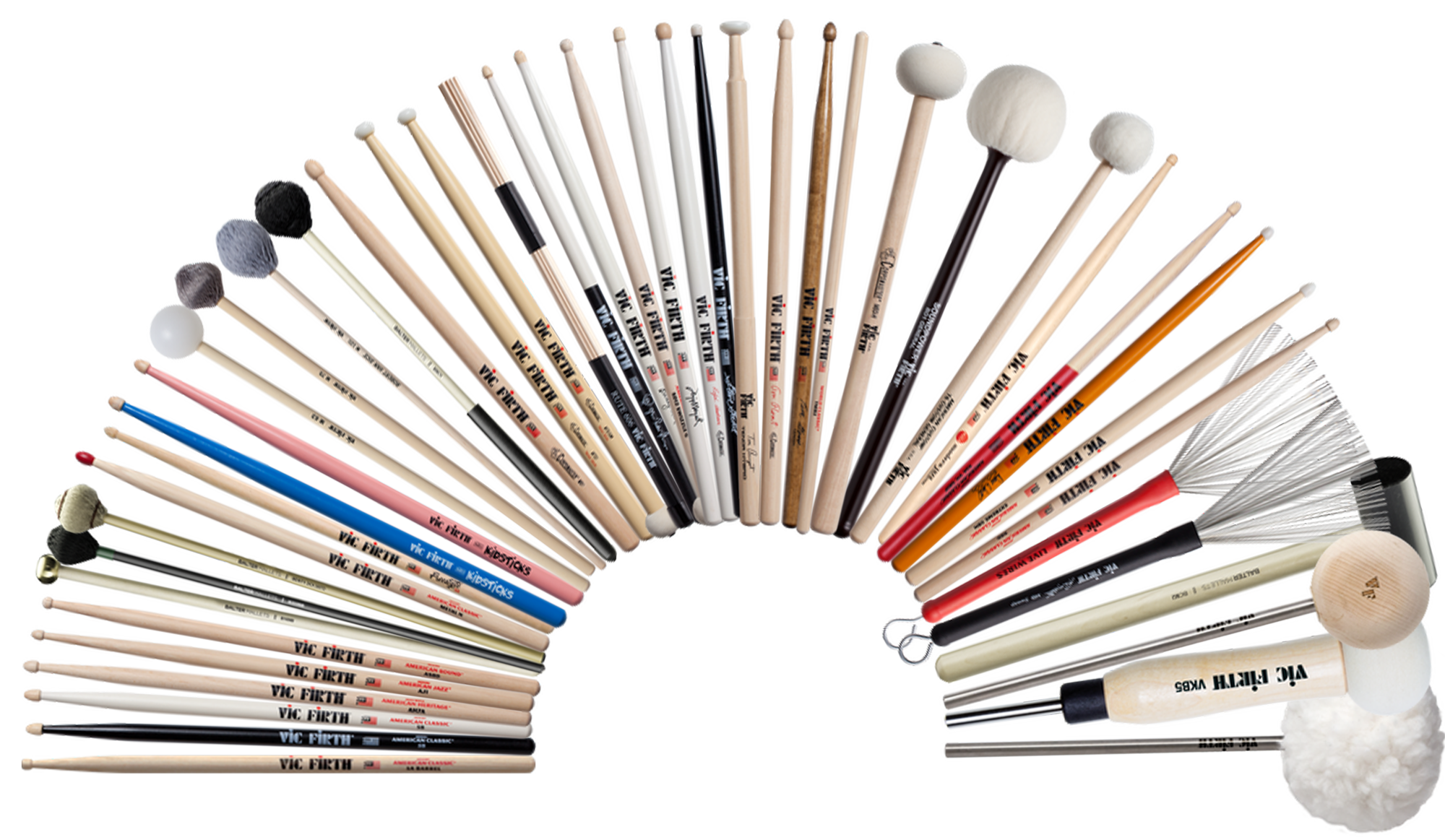Choose Your Weapon: Picking the Right Drum Sticks
One of the first things beginning drummers need to do is purchase a pair of sticks. Easy enough, right? You just waltz on into a music store, approach the counter, and proclaim, “I need to buy drum sticks!” And then the employee gleefully hands you a pair of sticks and rings you up and sends you on your merry way. What a breeze!
Except that’s not how it works at all.
Instead, you head into a music store, and get directed to a wall containing over 50 different options (literally) and are left to your own devices to figure out what exactly best suits your needs. Among the options are numbers and letters, like 5B, 7AN, SD1 General, and other cryptic combinations. And each stick seemingly has slightly different properties. Some have a rubber grip, a few are bright green, some look like a bunch of really skinny sticks bundled together. There are many different brands and price points.
Suffice to say, it can be a bit overwhelming. So let’s take a few moments to become familiar with the different options of drum sticks out there and how certain dimensions affect the sounds from the drums and cymbals.
Brands
While there are dozens of drum stick manufacturers in the market, the biggest companies are Vic Firth, Vater, ProMark, and Regal Tip. Every brand produces their own versions of the standard sizes (2B, 5A/5B, 7A), as well as numerous signature models that are more specialized for particular music settings. It’s also common for drum stick companies to produce custom models for artists that endorse their brand. ProMark makes a signature Neil Peart model, Vic Firth makes a signature Keith Carlock model, Vater makes a signature Mike Mangini model, and so on. It’s very possible that your favorite drummer has a signature stick model that you could buy and use. When you factor in all the signature models produced in addition to the standard sizes, there’s bound to be something out there that feels just right to you!
Size Matters
Drum sticks come in a wide array of sizes. Some smaller sticks feel like twigs compared to larger stick types, which can feel like swinging tree trunks. The size of a drum stick is typically labeled with a number followed by a letter (or a few). Generally speaking, the lower the number, the larger the stick. The higher the number, the smaller the stick.
For sticks designed for playing drum set, the numbered sizes range from 2 to 9, but there are some exceptions depending on the manufacturer. Most beginning drummers start with a 5A, which is roughly in the middle of the range of sizes. As you become more comfortable controlling the sticks, you may discover that you prefer something slightly larger or smaller than a 5A.
Most sizes have a couple variations. In the size 5 family, there’s also 5B, which is slightly larger than a 5A, or 5AN, which has the same dimensions as a 5A, but with a nylon tip instead of a wood tip (more on that in a bit). Some manufacturers produce models tangential to their standard sizes, like Vic Firth’s Extreme 5A, which is a bit longer than their standard 5A, or their 55A.
The style of music you intend to play will also inform which size stick you should buy. Bigger sticks generate bigger sounds more easily, but are more difficult to control. Smaller sticks make it easier to pull off subtle, intricate patterns, but require more work to get greater volumes.
Similar to shoes, there are small variances between the same models made by different companies. For example, a Vater Manhattan 7A is half an inch longer than a Vic Firth 7A. A half inch might not seem significant, but that small difference completely changes the responsiveness of the stick. Or how the tip on a ProMark 5A is a different shape compared to Vic Firth or Vater 5As, which also gives them a noticeably different feel and sound.
Outside of drum set styles, sticks can become even larger or smaller depending on their use. The drum sticks used on a marching snare drum are enormous, even compared to the 2Bs that some hard-hitting drummers use. But those huge sticks are perfect for the projection required for the outdoor setting of marching percussion. On the other end of the spectrum, timbale sticks are much skinnier than 7A’s and have no defining features. They’re just one uniform thickness with no other dimensions aside from rounded ends.
The Finer Details
Beyond the size of the stick, there are many other parameters that drastically impact how drum sticks feel, sound, and respond. The design of modern drum sticks is the result of decades of engineering and trial and error. Two elements in particular, the taper of the stick and the shape of the tip, do even more than size to determine how a stick feels.
The Taper
The taper (or shoulder) is the area of the stick where it narrows toward the tip. If you compare different sizes and styles of sticks, you’ll notice some sticks taper very drastically to an extremely narrow diameter, whereas others taper more gradually and to a lesser degree. The longer and more drastic the taper, the more responsive the stick will be.
Sticks commonly used for playing rock and louder styles of music typically have a shorter taper that doesn’t narrow down too much, which allows for harder playing, but at the cost of rebound and responsiveness. Drum sticks intended for use in jazz and quieter styles of music generally have a longer taper that can become as narrow as a chopstick in diameter. These sticks are incredibly responsive and allow users to play clean, precise multiple stroke patterns with ease, which is necessary for the practice of playing intricate cymbal patterns. However, these extreme tapers cannot withstand high-volume playing and can easily break if you’re not careful!
The Tip
In addition to the taper, stick tips also have a big impact on how a stick feels and sounds. There are many different shapes and sizes of stick tips, each resulting in a unique articulation when used around the drum set. Some tip shapes include acorn, tear drop, barrel, and ball. While almost all drum sticks are made of wood, tips are sometimes made out of a different material.
The most common tip materials are wood and nylon, but some manufacturers produce sticks with a metal tip or a rubber tip to produce a different sound. Wooden tips provide a more “organic” traditional tone, whereas nylon tips add a slight tinniness to articulations, especially on the cymbals. Nylon tips also generally last longer since wooden tips are susceptible to chipping when playing on harder surfaces for prolonged periods of time.
Larger tips typically accompany a larger stick, but the specific shape determines the articulation. Tear drop, oval, and acorn-shaped tips are the common choice among rock drummers since the larger surface area produces a wider attack, resulting in greater projection and a slightly darker tone. But the sound they produce may be a little too round for some of the more intricate patterns and phrasing common in jazz drumming.
Some of the models manufactured by Vic Firth
Barrel and ball tips are typically smaller and much rounder than other tip shapes. They rebound off of surfaces more easily, making them an ideal choice for more detailed styles of drumming. While they won’t project quite as much as larger tip shapes, they produce a brighter tone, giving more clarity to each stroke.
Stick Material
The overwhelming majority of sticks are made from wood, particularly hickory, maple, and oak. Each wood type has a different density, resulting in various weights and responsiveness.
Maple is the least dense of the bunch. Maple drum sticks are lighter and are best suited for quieter styles of drumming. However, their lower density and light weight comes at the cost of durability. It only takes one hard rim shot at just the right angle to snap skinnier models of maple sticks. On the flip side, playing faster around the drums is much easier since there’s less weight to throw around.
Hickory is the standard material for most drum sticks and what you will likely start out using as a beginning drummer. It’s a solid intersection between weight and durability, allowing for harder playing without forcing the user to exert too much effort. If you own a pair of drum sticks, chances are they’re made of hickory.
Oak wood is denser than both hickory and maple. Oak drum sticks have noticeably more weight to them and can really handle a beating. However, manufacturing oak is a more costly process, meaning that oak sticks cost substantially more than hickory or maple drum sticks. But if you aren’t an exceptionally hard-hitting drummer, then the added cost may be well worth the investment!
Some manufacturers produce sticks made from different materials like aluminum or plastic, or even sticks with a foam or rubber core to reduce impact vibrations. But wooden drum sticks will likely remain the standard for the foreseeable future.
Other Tools for the Job
While most of your drumming will be done with typical drum sticks, there are also many other types of “sticks” drummers use to produce a particular sound or texture. If you took a look into the stick bag of a typical gigging drummer (in the pre-covid era), they likely also have a pair of brushes, mallets, and hot rods.
Brushes
Brushes contain dozens of thin wires, usually made from metal or nylon, that bloom from a shaft. Brushes are the best tool for playing extremely quietly. They’re used to scrape across the surface of a snare drum, which creates a soft texture that easily blends into the sonic background. Drummers can also strike the drums and cymbals with brushes, which have a very wide attack. They’re typically retractable, allowing for an adjustable spread. A wider spread is better for scraping motions, whereas a narrower spread provides a more concrete articulation better suited toward rhythmic playing. Drumming with brushes is an art form all on its own!
Mallets
Mallets come in a wide range of sizes and dimensions depending on their intended use. Yarn mallets, for example, are designed for use with certain pitched percussion, like vibraphone. But those same mallets also work wonderfully on cymbals, allowing drummers to play dramatic cymbal swells. Yarn mallets have a much softer attack than sticks, but are more articulate than brushes. A skilled drummer can play a roll so smoothly on a cymbal that listeners won’t even be able to hear the individual strokes.
Harder mallets, such as those used on timpani, are made with a dense cotton tip. While still less articulate that typical wooden sticks, they have a noticeably sharper attack on drums and cymbals compared to yarn mallets. Hard mallets work exceptionally well on toms by providing a darker tone and more of a boost the mid and low range frequencies.
Hot Rods
Hot rods are kind of a fusion between brushes and regular sticks. They consist of many skinny wooden rods bound together. Some models of hot rods have an adjustable band, allowing drummers to control the spread of the rods. Similar to brushes, a wider spread produces a softer, fluffier attack, whereas a tighter spread is better for passages where more articulation is required. Due to their rigidity, hot rods feel much more like sticks than brushes, but they’re quite large compared to even 2B drum sticks. Hot rods are the ideal choice for small-room acoustic performances where sticks would be too loud.
Ultimately, finding the sticks that are best suited to the size of your hands and the way you play the drums is a process. You’ll need to try many different sizes and styles of sticks to determine what feels best. As you gain more drumming experience and your technique improves, you’ll have a better idea of what to look for in a pair of drum sticks.
The quickest way to learn the basics of technique and handling sticks is to begin taking drum lessons. Schedule a trial lesson to plan your drumming journey!







